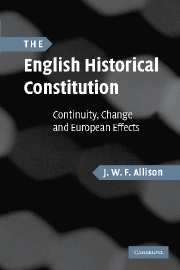Book contents
- Frontmatter
- Contents
- Table of Cases
- Preface
- 1 Introduction
- 2 A historical constitutional approach
- 3 The Crown: evolution through institutional change and conservation
- 4 The separation of powers as a customary practice
- 5 Parliamentary sovereignty and the European Community: the economy of the common law
- 6 The brief rule of a controlling common law
- 7 Dicey's progressive and reactionary rule of law
- 8 Beyond Dicey
- Conclusions and implications
- Bibliography
- Index
6 - The brief rule of a controlling common law
Published online by Cambridge University Press: 18 December 2009
- Frontmatter
- Contents
- Table of Cases
- Preface
- 1 Introduction
- 2 A historical constitutional approach
- 3 The Crown: evolution through institutional change and conservation
- 4 The separation of powers as a customary practice
- 5 Parliamentary sovereignty and the European Community: the economy of the common law
- 6 The brief rule of a controlling common law
- 7 Dicey's progressive and reactionary rule of law
- 8 Beyond Dicey
- Conclusions and implications
- Bibliography
- Index
Summary
From a historical constitutional perspective on the Crown's evolution and the key doctrinal developments that have already been discussed, the constitution is lacking in systemic elaboration and limited in express normativity. The Crown, the constitution's institutional centrepiece, remains analytically obscure – the ambivalent outcome of institutional change and conservation. The rough English separation of powers was not established through authoritative declarations of principle but has evolved and continues to evolve as an uneven customary practice in doctrine, case law and legislation. In accommodating the supremacy of Community law, the judicial adaptations to the doctrine on parliamentary sovereignty, Dicey's one pillar of the constitution, discussed in Chapter Five, illustrate, not the articulation of principles of legal and political morality, but the traditional economy of principle in the common law. Amidst the elusive principles, half-submerged in common-law practice, the rule of law, Dicey's other pillar – its formation, clarity and capacity to serve as the normative linchpin in the historical constitution, or as itself a form of constitution – requires consideration.
The rule of law, for example, was invoked to justify and applaud the judicial recognition of the availability of an injunction and contempt jurisdiction against officers of the Crown, discussed in Chapter Three. It may also be interpreted to curtail residual Crown immunities or to embrace a Republican principle of equality that precludes the very concept of the Crown and the centrality of the monarch it connotes.
- Type
- Chapter
- Information
- The English Historical ConstitutionContinuity, Change and European Effects, pp. 128 - 156Publisher: Cambridge University PressPrint publication year: 2007



